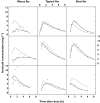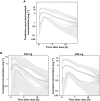Variability in the population pharmacokinetics of isoniazid in South African tuberculosis patients
- PMID: 21320152
- PMCID: PMC3141186
- DOI: 10.1111/j.1365-2125.2011.03940.x
Variability in the population pharmacokinetics of isoniazid in South African tuberculosis patients
Abstract
Aim: This study was designed to characterize the population pharmacokinetics of isoniazid in South African pulmonary tuberculosis patients.
Methods: Concentration-time measurements obtained from 235 patients receiving oral doses of isoniazid as part of routine tuberculosis chemotherapy in two clinical studies were pooled and subjected to nonlinear mixed-effects analysis.
Results: A two-compartmental model, including first-order absorption and elimination with allometric scaling, was found to describe the observed dose-exposure relationship for oral isoniazid adequately. A mixture model was used to characterize dual rates of isoniazid elimination. Estimates of apparent clearance in slow and fast eliminators were 9.70 and 21.6 l h(-1) , respectively. The proportion of fast eliminators in the population was estimated to be 13.2%. Central volume of distribution was estimated to be 10% smaller in female patients and clearance was found to be 17% lower in patients with HIV. Variability in absorption rate (90%) was completely interoccasional in nature, whereas in relative bioavailability, interoccasional variability (8.4%) was lower than interindividual variability (26%). Oral doses, given once daily according to dosing policies at the time, were sufficient to reach therapeutic concentrations in the majority of the studied population, regardless of eliminator phenotype. Simulations suggested that current treatment guidelines (5 mg kg(-1) ) may be suboptimal in fast eliminators with low body weight.
Conclusions: A population pharmacokinetic model was developed to characterize the highly variable pharmacokinetics of isoniazid in a South African pulmonary tuberculosis patient population. Current treatment guidelines may lead to underexposure in rapid isoniazid eliminators.
© 2011 The Authors. British Journal of Clinical Pharmacology © 2011 The British Pharmacological Society.
Figures





Similar articles
-
Model-based precision dosing and remedial dosing recommendations for delayed or missed doses of isoniazid in Chinese patients with tuberculosis.Br J Clin Pharmacol. 2025 Apr;91(4):947-956. doi: 10.1111/bcp.16050. Epub 2024 Apr 3. Br J Clin Pharmacol. 2025. PMID: 38570184
-
Population pharmacokinetics of rifampicin, pyrazinamide and isoniazid in children with tuberculosis: in silico evaluation of currently recommended doses.J Antimicrob Chemother. 2014 May;69(5):1339-49. doi: 10.1093/jac/dkt524. Epub 2014 Jan 31. J Antimicrob Chemother. 2014. PMID: 24486870 Free PMC article.
-
HIV-1 Coinfection Does Not Reduce Exposure to Rifampin, Isoniazid, and Pyrazinamide in South African Tuberculosis Outpatients.Antimicrob Agents Chemother. 2016 Sep 23;60(10):6050-9. doi: 10.1128/AAC.00480-16. Print 2016 Oct. Antimicrob Agents Chemother. 2016. PMID: 27480859 Free PMC article.
-
A Systematic Review and Meta-analysis of Isoniazid Pharmacokinetics in Healthy Volunteers and Patients with Tuberculosis.Clin Ther. 2020 Nov;42(11):e220-e241. doi: 10.1016/j.clinthera.2020.09.009. Epub 2020 Oct 5. Clin Ther. 2020. PMID: 33032843
-
Tuberculosis in the 1980s, with particular reference to South Africa.S Afr Med J. 1982 Sep 4;62(11):359-64. S Afr Med J. 1982. PMID: 7051364 Review.
Cited by
-
Isoniazid pharmacokinetics, pharmacodynamics, and dosing in South African infants.Ther Drug Monit. 2012 Aug;34(4):446-51. doi: 10.1097/FTD.0b013e31825c4bc3. Ther Drug Monit. 2012. PMID: 22695364 Free PMC article. Clinical Trial.
-
Development of visual predictive checks accounting for multimodal parameter distributions in mixture models.J Pharmacokinet Pharmacodyn. 2019 Jun;46(3):241-250. doi: 10.1007/s10928-019-09632-9. Epub 2019 Apr 9. J Pharmacokinet Pharmacodyn. 2019. PMID: 30968312 Free PMC article.
-
Comparative Efficacy of Rifapentine Alone and in Combination with Isoniazid for Latent Tuberculosis Infection: a Translational Pharmacokinetic-Pharmacodynamic Modeling Study.Antimicrob Agents Chemother. 2021 Nov 17;65(12):e0170521. doi: 10.1128/AAC.01705-21. Epub 2021 Oct 4. Antimicrob Agents Chemother. 2021. PMID: 34606336 Free PMC article.
-
Drug concentration at the site of disease in children with pulmonary tuberculosis.J Antimicrob Chemother. 2022 May 29;77(6):1710-1719. doi: 10.1093/jac/dkac103. J Antimicrob Chemother. 2022. PMID: 35468189 Free PMC article.
-
A review of clinical pharmacogenetics Studies in African populations.Per Med. 2020 Mar;17(2):155-170. doi: 10.2217/pme-2019-0110. Epub 2020 Mar 3. Per Med. 2020. PMID: 32125935 Free PMC article. Review.
References
-
- World Health Organization. Global Tuberculosis Control: WHO Report 2010. WHO/HTM/TB/2010.7. Geneva: World Health Organization; 2010.
-
- Wood R. The case for integrating tuberculosis and HIV treatment services in South Africa. J Infect Dis. 2007;196(Suppl 3):S497–499. - PubMed
-
- Jindani A, Aber VR, Edwards EA, Mitchison DA. The early bactericidal activity of drugs in patients with pulmonary tuberculosis. Am Rev Respir Dis. 1980;121:939–49. - PubMed
-
- Donald PR, Sirgel FA, Botha FJ, Seifart HI, Parkin DP, Vandenplas ML, van de Wal BW, Maritz JS. The early bactericidal activity of isoniazid related to its dose size in pulmonary tuberculosis. Am J Respir Crit Care Med. 1997;156:895–900. - PubMed
-
- Donald PR, Sirgel FA, Venter A, Parkin DP, Seifart HI, van de Wal BW, Werely C, van Helden PD, Maritz JS. The influence of human N-acetyltransferase genotype on the early bactericidal activity of isoniazid. Clin Infect Dis. 2004;39:1425–30. - PubMed
Publication types
MeSH terms
Substances
LinkOut - more resources
Full Text Sources

